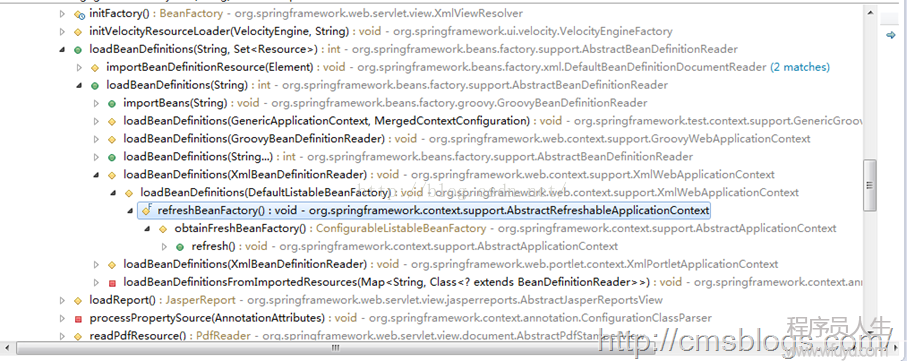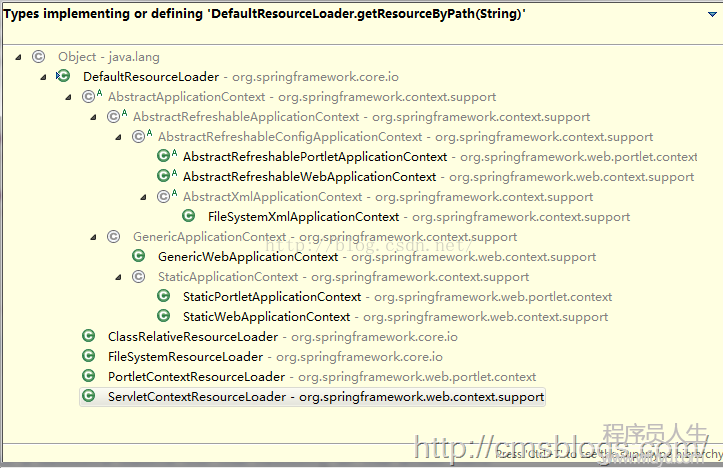【初探Spring】——Spring IOC(三):初始化過程—Resource定位
來源:程序員人生 發布時間:2016-07-19 13:07:59 閱讀次數:3672次
我們知道Spring的IoC起到了1個容器的作用,其中裝得都是各種各樣的Bean。同時在我們剛剛開始學習Spring的時候都是通過xml文件來定義Bean,Spring會某種方式加載這些xml文件,然后根據這些信息綁定全部系統的對象,終究組裝成1個可用的基于輕量級容器的利用系統。
Spring IoC容器整體可以劃分為兩個階段,容器啟動階段,Bean實例化階段。其中容器啟動階段蛀牙包括加載配置信息、解析配置信息,設備到BeanDefinition中和其他后置處理,而Bean實例化階段主要包括實例化對象,裝配依賴,生命周期管理已注冊回調。下面LZ先介紹容器的啟動階段的第1步,即定位配置文件。
我們使用編程方式使用DefaultListableBeanFactory時,首先是需要定義1個Resource來定位容器使用的BeanDefinition。
ClassPathResource resource = new ClassPathResource("bean.xml");
通過這個代碼,就意味著Spring會在類路徑中去尋覓bean.xml并解析為BeanDefinition信息。固然這個Resource其實不能直接被使用,他需要被BeanDefinitionReader進行解析處理(這是后面的內容了)。
對各種applicationContext,如FileSystemXmlApplicationContext、ClassPathXmlApplicationContext等等,我們從這些類名就能夠看到他們提供了那些Resource的讀入功能。下面我們以FileSystemXmlApplicationContext為例來論述Spring IoC容器的Resource定位。
先看FileSystemXmlApplicationContext繼承體系結構:

從圖中可以看出FileSystemXMLApplicationContext繼承了DefaultResourceLoader,具有了Resource定義的BeanDefinition的能力,其源代碼以下:
public class FileSystemXmlApplicationContext extends AbstractXmlApplicationContext {
/**
* 默許構造函數
*/
public FileSystemXmlApplicationContext() {
}
public FileSystemXmlApplicationContext(ApplicationContext parent) {
super(parent);
}
public FileSystemXmlApplicationContext(String configLocation) throws BeansException {
this(new String[] {configLocation}, true, null);
}
public FileSystemXmlApplicationContext(String... configLocations) throws BeansException {
this(configLocations, true, null);
}
public FileSystemXmlApplicationContext(String[] configLocations, ApplicationContext parent) throws BeansException {
this(configLocations, true, parent);
}
public FileSystemXmlApplicationContext(String[] configLocations, boolean refresh) throws BeansException {
this(configLocations, refresh, null);
}
//核心構造器
public FileSystemXmlApplicationContext(String[] configLocations, boolean refresh, ApplicationContext parent)
throws BeansException {
super(parent);
setConfigLocations(configLocations);
if (refresh) {
refresh();
}
}
//通過構造1個FileSystemResource對象來得到1個在文件系統中定位的BeanDefinition
//采取模板方法設計模式,具體的實現用子類來完成
protected Resource getResourceByPath(String path) {
if (path != null && path.startsWith("/")) {
path = path.substring(1);
}
return new FileSystemResource(path);
}
}
AbstractApplicationContext中的refresh()方法是IoC容器初始化的入口,也就是說IoC容器的初始化是通過refresh()方法來完成全部調用進程的。在核心構造器中就對refresh進行調用,通過它來啟動IoC容器的初始化工作。getResourceByPath為1個模板方法,通過構造1個FileSystemResource對象來得到1個在文件系統中定位的BeanDEfinition。getResourceByPath的調用關系以下(部份):

refresh為初始化IoC容器的入口,但是具體的資源定位還是在XmlBeanDefinitionReader讀入BeanDefinition時完成,loadBeanDefinitions() 加載BeanDefinition的載入。
protected final void refreshBeanFactory() throws BeansException {
//判斷是不是已創建了BeanFactory,如果創建了則燒毀關閉該BeanFactory
if (hasBeanFactory()) {
destroyBeans();
closeBeanFactory();
}
try {
//創建DefaultListableBeanFactory實例對象
DefaultListableBeanFactory beanFactory = createBeanFactory();
beanFactory.setSerializationId(getId());
customizeBeanFactory(beanFactory);
//加載BeanDefinition信息
loadBeanDefinitions(beanFactory);
synchronized (this.beanFactoryMonitor) {
this.beanFactory = beanFactory;
}
}
catch (IOException ex) {
throw new ApplicationContextException("I/O error parsing bean definition source for " + getDisplayName(), ex);
}
}
DefaultListableBeanFactory作為BeanFactory默許實現類,其重要性不言而喻,而createBeanFactory()則返回該實例對象。
protected DefaultListableBeanFactory createBeanFactory() {
return new DefaultListableBeanFactory(getInternalParentBeanFactory());
}
loadBeanDefinition方法加載BeanDefinition信息,BeanDefinition就是在這里定義的。AbstractRefreshableApplicationContext對loadBeanDefinitions僅僅只是定義了1個抽象的方法,真實的實現類為其子類AbstractXmlApplicationContext來實現:
AbstractRefreshableApplicationContext:
protected abstract void loadBeanDefinitions(DefaultListableBeanFactory beanFactory)
throws BeansException, IOException;
AbstractXmlApplicationContext:
protected void loadBeanDefinitions(DefaultListableBeanFactory beanFactory) throws BeansException, IOException {
//創建bean的讀取器(Reader),即XmlBeanDefinitionReader,并通過回調設置到容器中
XmlBeanDefinitionReader beanDefinitionReader = new XmlBeanDefinitionReader(beanFactory);
//
beanDefinitionReader.setEnvironment(getEnvironment());
//為Bean讀取器設置Spring資源加載器
beanDefinitionReader.setResourceLoader(this);
//為Bean讀取器設置SAX xml解析器
beanDefinitionReader.setEntityResolver(new ResourceEntityResolver(this));
//
initBeanDefinitionReader(beanDefinitionReader);
//Bean讀取器真正實現的地方
loadBeanDefinitions(beanDefinitionReader);
}
程序首先首先創建1個Reader,在前面就提到過,每類資源都對應著1個BeanDefinitionReader,BeanDefinitionReader提供統1的轉換規則;然后設置Reader,最后調用loadBeanDefinition,該loadBeanDefinition才是讀取器真正實現的地方:
protected void loadBeanDefinitions(XmlBeanDefinitionReader reader) throws BeansException, IOException {
//獲得Bean定義資源的定位
Resource[] configResources = getConfigResources();
if (configResources != null) {
reader.loadBeanDefinitions(configResources);
}
//獲得Bean定義資源的路徑。在FileSystemXMLApplicationContext中通過setConfigLocations可以配置Bean資源定位的路徑
String[] configLocations = getConfigLocations();
if (configLocations != null) {
reader.loadBeanDefinitions(configLocations);
}
}
首先通過getConfigResources()獲得Bean定義的資源定位,如果不為null則調用loadBeanDefinitions方法來讀取Bean定義資源的定位。
loadBeanDefinitions是中的方法:
public int loadBeanDefinitions(String... locations) throws BeanDefinitionStoreException {
Assert.notNull(locations, "Location array must not be null");
int counter = 0;
for (String location : locations) {
counter += loadBeanDefinitions(location);
}
return counter;
}
繼續:
public int loadBeanDefinitions(String location) throws BeanDefinitionStoreException {
return loadBeanDefinitions(location, null);
}
再繼續:
public int loadBeanDefinitions(String location, Set<Resource> actualResources) throws BeanDefinitionStoreException {
//獲得ResourceLoader資源加載器
ResourceLoader resourceLoader = getResourceLoader();
if (resourceLoader == null) {
throw new BeanDefinitionStoreException(
"Cannot import bean definitions from location [" + location + "]: no ResourceLoader available");
}
//
if (resourceLoader instanceof ResourcePatternResolver) {
try {
//調用DefaultResourceLoader的getResourceByPath完成具體的Resource定位
Resource[] resources = ((ResourcePatternResolver) resourceLoader).getResources(location);
int loadCount = loadBeanDefinitions(resources);
if (actualResources != null) {
for (Resource resource : resources) {
actualResources.add(resource);
}
}
if (logger.isDebugEnabled()) {
logger.debug("Loaded " + loadCount + " bean definitions from location pattern [" + location + "]");
}
return loadCount;
}
catch (IOException ex) {
throw new BeanDefinitionStoreException(
"Could not resolve bean definition resource pattern [" + location + "]", ex);
}
}
else {
//調用DefaultResourceLoader的getResourceByPath完成具體的Resource定位
Resource resource = resourceLoader.getResource(location);
int loadCount = loadBeanDefinitions(resource);
if (actualResources != null) {
actualResources.add(resource);
}
if (logger.isDebugEnabled()) {
logger.debug("Loaded " + loadCount + " bean definitions from location [" + location + "]");
}
return loadCount;
}
}
在這段源代碼中通過調用DefaultResourceLoader的getResource方法:
public Resource getResource(String location) {
Assert.notNull(location, "Location must not be null");
if (location.startsWith("/")) {
return getResourceByPath(location);
}
//處理帶有classPath標識的Resource
else if (location.startsWith(CLASSPATH_URL_PREFIX)) {
return new ClassPathResource(location.substring(CLASSPATH_URL_PREFIX.length()), getClassLoader());
}
else {
try {
//處理URL資源
URL url = new URL(location);
return new UrlResource(url);
}
catch (MalformedURLException ex) {
return getResourceByPath(location);
}
}
}
在getResource方法中我們可以清晰地看到Resource資源的定位。這里可以清晰地看到getResourceByPath方法的調用,getResourceByPath方法的具體實現有子類來完成,在FileSystemXmlApplicationContext實現以下:
protected Resource getResourceByPath(String path) {
if (path != null && path.startsWith("/")) {
path = path.substring(1);
}
return new FileSystemResource(path);
}
這樣代碼就回到了博客開初的FileSystemXmlApplicationContext 中來了,它提供了FileSystemResource 來完成從文件系統得到配置文件的資源定義。固然這僅僅只是Spring IoC容器定位資源的1種邏輯,我們可以根據這個步驟來查看Spring提供的各種資源的定位,如ClassPathResource、URLResource等等。下圖是ResourceLoader的繼承關系:
這里就差不多分析了Spring IoC容器初始化進程資源的定位,在BeanDefinition定位完成的基礎上,就能夠通過返回的Resource對象來進行BeanDefinition的載入、解析了。
下篇博客將探索Spring IoC容器初始化進程的解析,Spring Resource體系結構會在后面詳細講授。
參考文獻
1、《Spring技術內幕 深入解析Spring架構與設計原理》–第2版
2、Spring:源碼解讀Spring IOC原理
3、【Spring】IOC核心源碼學習(2):容器初始化進程
生活不易,碼農辛苦
如果您覺得本網站對您的學習有所幫助,可以手機掃描二維碼進行捐贈




